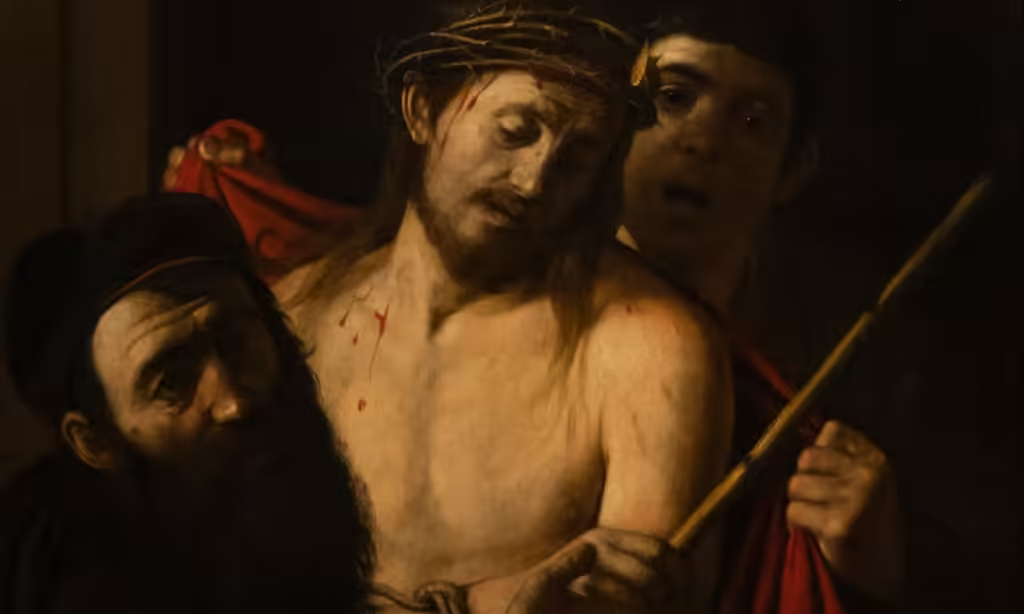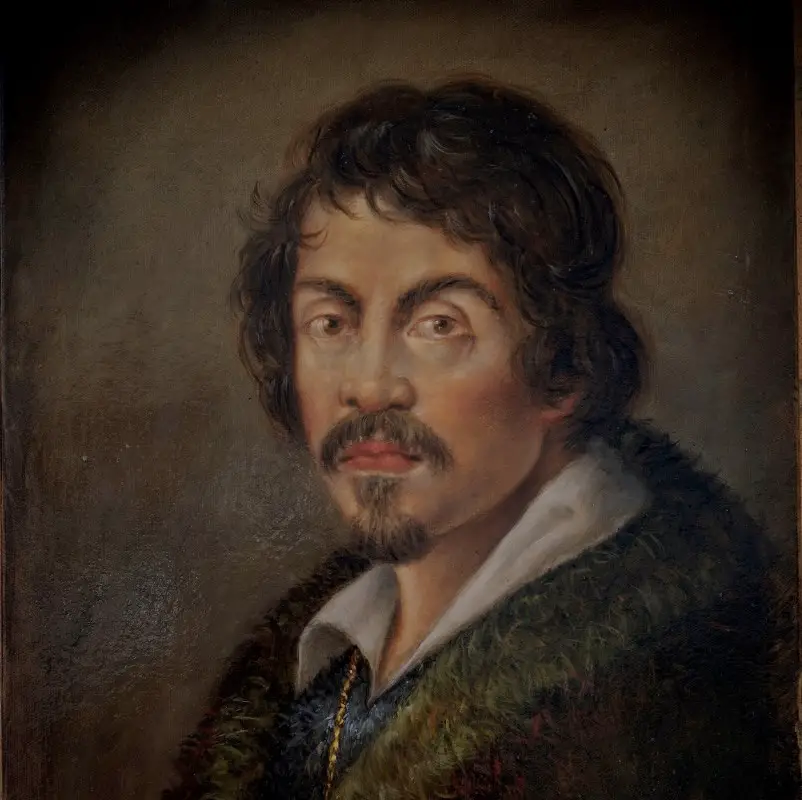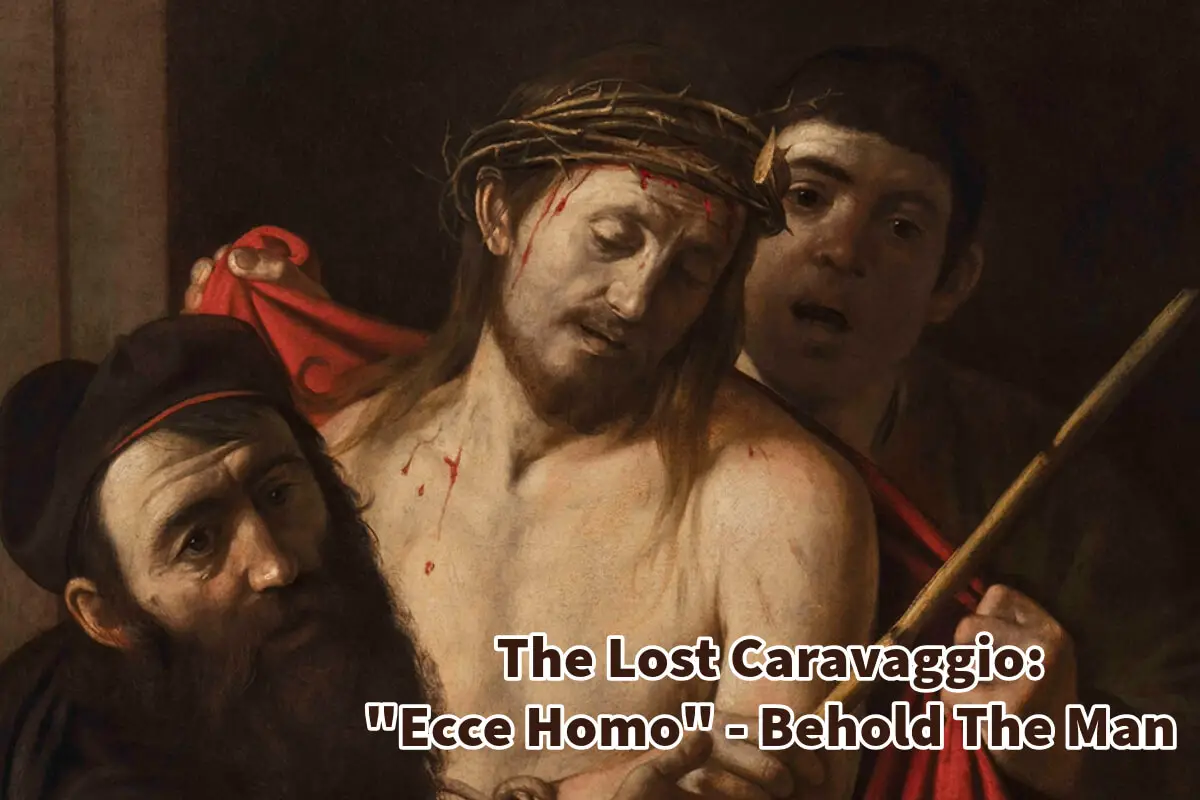Caravaggio is undoubtedly an artist who is often mentioned alongside greats like Leonardo da Vinci, Rembrandt, and Michelangelo. Known for his dramatic use of light and shadow, realistic portrayals, and intense emotional content, Caravaggio’s works have left an indelible mark on the art world.
Among his many masterpieces, one painting, in particular, stands out for its history as well as its artistic brilliance: “Ecce Homo.” Remarkably, this painting was lost for a long time and almost sold at an auction for a bargain price of USD 1,600, adding to its mystique and value as an incredible masterpiece.
Table of Contents
- About The Painting: “Ecce Homo” Or Behold The Man
- Unique Features Of “Ecce Homo”
- Caravaggio’s Life During The Creation Of “Ecce Homo”
- The Almost USD 1,600 Auction Of The Ecce Homo Painting
- Related Questions
About The Painting: “Ecce Homo” Or Behold The Man
Ecce Homo,” which translates to “Behold the Man,” is considered one of the lost masterpieces of Caravaggio, the great Italian painter. Created between 1605 and 1609, this painting is a classic example of Caravaggio’s work.

The painting depicts a poignant moment from the Passion of Christ. It shows Jesus, after being arrested and tormented by Roman soldiers, brought before Pontius Pilate, the Roman governor of Judea.
According to the Gospel of Saint John (19:2-5), Christ is presented to the crowd wearing a crown of thorns, a reed scepter, and a purple robe. Each item, arranged by his tormentors, mockingly symbolizes Christ’s claim to be King of the Jews.
In St John 19:2-5 it records:
“2 And the soldiers plaited a crown of thorns, and put it on his head, and they put on him a purple robe,
St John 19:2 -5, King James Version
3 And said, Hail, King of the Jews! and they smote him with their hands.
4 Pilate therefore went forth again, and saith unto them, Behold, I bring him forth to you, that ye may know that I find no fault in him.
5 Then came Jesus forth, wearing the crown of thorns, and the purple robe. And Pilate saith unto them, Behold the man”
In the painting, you can see the indecision in Pilate’s hands as Pilate announces the pitiful sight with the words, “Behold the man!” (“Ecce homo”), showing Christ’s suffering.
The painting is believed to have been part of Philip IV of Spain’s private collection. It is one of only around 69 works by Caravaggio, making it one of the most valuable old artworks in the world.
Unique Features Of “Ecce Homo”
The rediscovery of “Ecce Homo” is monumental not only because it is a lost work by Caravaggio but also due to the classic attributes that define his artistic genius. Here are some of the key elements that make this painting a masterpiece:
Composition And Characters
Pilate is the figure closest to the viewer, leaning definitely towards Christ on the left. Engaging both the implied crowd and the viewer directly, Pilate is racked with indecision.
Finding no evidence for the charge against Christ, the Roman governor hands Jesus’s fate to the crowd, who condemn him to die by shouting, “Crucify him!” Right after Pilate says Ecce Homo or Behold the Man, meaning behold the Man you call Jesus or Christ.
Christ occupies the center of the composition, brightly illuminated with the dramatic chiaroscuro typical of Caravaggio’s style. Vivid blood spots echo the rich crimson of the soldier’s mockingly draped robe across his shoulders, contrasting his pale flesh.
Sorrowful and resigned, Christ is caught in the middle of this tightly arranged group, positioned diagonally across the picture plane by the artist. Christ’s reed scepter draws the viewer’s eye in the same direction.
The final figure looms behind Christ with an open mouth, perhaps shouting to the crowd, heightening the sense of drama and indecision.
Sharp points of white paint in his eyes convey turbulent emotions and almost excitement by the figure in the back behind Christ; it’s unclear whether he is moved by hatred, panic, or pity. But we see this third figure grasping the rob, ready to place it on Christ.
The three characters each recall models used by Caravaggio in earlier paintings, and their dramatic gestures are characteristic of the artist’s preferred method for communicating narrative.
Symbolism And Themes
The crown of thorns and the blood dripping from it emphasize the physical and emotional torment Christ endured. Even though Christ has a stick in his hand, we know that Pilate holds the power in all this and the power to decide Christ’s fate.
Many Christians believe the re being draped over Christ’s scan holds religious significance, symbolizing Christ’s prophetic sacrifice, which is blood sacrifice.
Caravaggio’s use of chiaroscuro draws the viewer’s attention to Christ while shrouding Pilate and the other figure in darkness, heightening the emotional intensity of the scene.

Caravaggio’s Life During The Creation Of “Ecce Homo”
Caravaggio had to flee Rome, where he had gained fame as a painter, after fatally wounding a man named Ranuccio Tomassoni in 1606 during a dispute. To avoid the death penalty associated with the crime, the painter left the city in May 1606, heading to Naples.
Following successful commissions, the artist traveled to Malta in 1607 and became a knight of the Order of Saint John. After little more than a year in Malta, Caravaggio departed suddenly, perhaps following the discovery of his criminal background. He then went to Sicily and back to Naples, hoping to receive news of a possible pardon.
“Ecce Homo” was painted during those troubled years and reflects the tension of a fugitive working desperately, pleading to be allowed back home to Rome. It demonstrates how his later work developed into a quicker and more concise style than previous years, but it never lacked precise details.
The Almost USD 1,600 Auction Of The Ecce Homo Painting
In April 2021, the Prado Museum alerted the Spanish Ministry of Culture to the relevance of this painting when it appeared at an Ansorena auction house. Initially attributed to a pupil of Jose de Ribera, it was later confirmed to be an original Caravaggio.
This revelation sparked significant interest and excitement among art historians and enthusiasts worldwide. Andrea Cipriani and his team meticulously restored the painting, which needed restoration.
The recognition and restoration of “Ecce Homo” represent one of the most significant art discoveries of the decade. Experts in Caravaggio and Baroque painting universally agree that this painting is a lost masterpiece of the great Italian artist.
So, how did a disabled painting get lost and almost sold for so little? Thanks to the careful care of some art experts in Spain, they moved quickly to stop the painting from being sold at such a low price and insisted that it be more carefully examined.
Provenance And Historical Significance
“Ecce Homo” is strongly connected to the history of Spanish collecting. Although it is unknown for whom and when it was painted, it first appears with a fair degree of certainty in 1631, among the assets of Juan de Lezcano, a secretary to the Spanish viceroy in Naples.
The painting “Ecce Homo” boasts a rich and detailed provenance, tracing its ownership through several notable figures and institutions. This history adds to its significance as a lost masterpiece by Caravaggio.
Early Provenance
The work was previously owned by the three children of Antonio Pérez de Castro, founder of Madrid’s IADE design school, and the artist Mercedes Méndez Attard. However, its documented history goes much further back. “Ecce Homo” is believed to have been included in the private collection of Philip IV of Spain in 1664. It was later mentioned as being on display in the apartment of his son, Charles II, from 1701 until 1702.
Exhibition And Ownership
In 1789, “Ecce Homo” was exhibited at the Real Casa del Palacio del Buen Retiro in Madrid, a significant venue that added to the painting’s prestige. By 1816, the piece was documented in the collection of Manuel Godoy, the Spanish Secretary of State to Charles IV.
Following Godoy’s possession, the painting was bequeathed to the Real Academia de San Fernando, further cementing its place in the annals of Spanish art history.
Exchange And Recent Ownership
In 1821, Evaristo Pérez de Castro Méndez, a Spanish diplomat and honorary Real Academia de San Fernand member, received the Caravaggio in exchange for other paintings gifted to the fine arts academy.
The painting remained with his family until it changed ownership in 2024. A press statement noted this transition, highlighting the painting’s enduring legacy and the meticulous care with which its provenance has been documented.

Caravaggio’s Enduring Legacy
Caravaggio, often labeled the “bad boy” of Baroque art, continues to capture the public’s imagination. His dramatic use of light and shadow and intense and often controversial personal life make him a fascinating figure in art history. The rediscovery and documentation of “Ecce Homo” not only add to his illustrious legacy but also provide a deeper understanding of his work and its impact on future generations of artists and collectors.
Caravaggio’s “Ecce Homo” is a profound depiction of Christ’s suffering and impending crucifixion. Through his masterful use of light and shadow and the poignant details of the scene, Caravaggio conveys a powerful narrative of pain, power, and sacrifice.
The rediscovery of this lost masterpiece not only adds to Caravaggio’s illustrious legacy but also provides a poignant reminder of the enduring power of his art. Caravaggio’s works continue to captivate audiences with their raw emotional intensity and dramatic realism.
“Ecce Homo” stands as a testament to his genius, offering a glimpse into the profound themes of suffering, authority, and compassion that define his oeuvre.
Listen To Our Podcast About
Is This the Lost Caravaggio: ‘Ecce Homo’?
Below or By clicking here.

Anita Louise Art is dedicated to art education, great artists, and inspiring others to find and create their art. We love art that uplifts and inspires. #ArtToMakeYouSmile! #ArtToMakeYouHappy!
If you are interested to see any of my art, you can find out more by clicking here. If you are interested in what inspires me and my paintings, you can discover more by clicking here.
We have a free newsletter and would love you to be part of our community; you can subscribe to the newsletter by clicking here. I would be happy to talk to you if you have any questions. You can reach me, Anita, by clicking here.
Subscribe to our Anita Louise Art YouTube Channel with great videos and information by clicking here.
Join us for our podcast “5 Minutes With Art.” Spend just 5 minutes a week with us to discover and learn about great art and artists. You can find out more about our podcast by clicking here.
Related Questions
Frida Kahlo’s Death And Life Of Pain On The Canvas Explored
Frida Kahlo passed away in 1954, approximately a year after undergoing the amputation of her right leg. Even in death, her life is shrouded in mystery as rumors circulate about the actual cause of her passing. Continue reading to delve deeper into the art, life, and enigmatic death of Frida Kahlo.
By clicking here, you can learn more by reading Frida Kahlo’s Death And Life Of Pain On The Canvas Explored.
Why Are Mark Rothko’s Paintings Considered Special?
Mark Rothko’s paintings are remarkable because they are original works of art. He is one of the founders of the abstract expressionism movement and color field painting. But more than that, he believed that his spirit lives within the art and that we, the individuals, can view his art can be taken to a different realm.
By clicking here, you can discover more by reading Why Are Mark Rothko’s Paintings Considered Special?
Andy Warhol’s Obsession With For Marilyn Monroe
Andy Warhol, the visionary artist of the pop art movement, left an indelible mark on the art world with his distinctive style and exploration of celebrity culture. Among his vast work, one recurring figure stands out: the iconic American movie star Marilyn Monroe.
By clicking here, you can learn more by reading Andy Warhol’s Obsession With For Marilyn Monroe.

